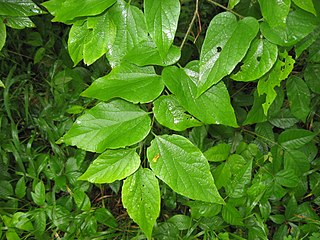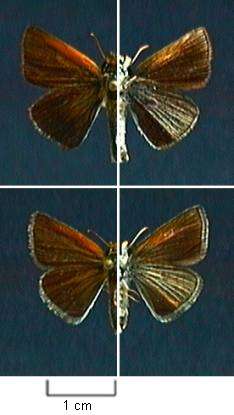
Hibiscus moscheutos, the rose mallow, swamp rose-mallow, crimsoneyed rosemallow, or eastern rosemallow, is a species of flowering plant in the family Malvaceae. It is a cold-hardy perennial wetland plant that can grow in large colonies. The hirsute leaves are of variable morphology, but are commonly deltoidal in shape with up to three lobes. It is found in wetlands and along the riverine systems of the eastern United States from Texas to the Atlantic states, its territory extending northward to southern Ontario.

The Peary caribou is a subspecies of caribou found in the High Arctic islands of Nunavut and the Northwest Territories in Canada. They are the smallest of the North American caribou, with the females weighing an average of 60 kg (130 lb) and the males 110 kg (240 lb). In length the females average 1.4 m and the males 1.7 m.

Celtis tenuifolia, the dwarf hackberry or Georgia hackberry is a shrub or small tree 2-to-12-metre-high. It is native to eastern North America but is very uncommon north of the Ohio River. In Canada, dwarf hackberry is designated as threatened and protected under Canada's Species at Risk Act.

Ivesia muirii is a species of flowering plant in the rose family known by the common name granite mousetail. It is endemic to the High Sierra Nevada of California, where it grows on rocky slopes and cliffs.

Boechera hoffmannii is a rare species of flowering plant in the family Brassicaceae known by the common name Hoffmann's rockcress. It is endemic to the Channel Islands of California, where it is known from only three or four populations on two of the eight islands. A 2005 report estimated a remaining global population of 244 individual plants. It is a federally listed endangered species.

Arctostaphylos imbricata is a species of manzanita known by the common name San Bruno Mountain manzanita.

Brickellia desertorum is a species of flowering plant in the family Asteraceae known by the common names desert brickellbush and desert brickellia. It is native to Mexico, Central America, the West Indies, and the southwestern United States.

Linanthus maculatus is a species of flowering plant in the phlox family known by the common names San Bernardino Mountain gilia and Little San Bernardino Mountains gilia. It is endemic to California, where it is known only from a few locales in the Little San Bernardino Mountains and the adjacent Palm Springs area in the northern end of the Coachella Valley. The largest populations, which may contain thousands of individuals, are located within the bounds of Joshua Tree National Park. This is a very small annual herb no more than three centimeters high. It has a taproot which may exceed 6 centimeters in length to collect moisture from the dry desert sand in its native habitat. The tiny, hairy stem branches to form small matted clusters on the sand surface. The hairy leaves are just a few millimeters long and unlobed. The inflorescence is a dense cluster of flowers each only 2 to 5 millimeters wide. The flower corolla has curled-back lobes which are white, sometimes with a spot of purple or pink. The protruding stamens are yellow. The main threat to this species is development in its range, and it is also vulnerable to off-road vehicle damage in the wide open sandy flats where it grows.

Lupinus brevicaulis is a species of lupine known by the common names shortstem lupine and sand lupine. It is native to the southwestern United States, including Oregon, California, Nevada, Utah, Colorado, Arizona, and New Mexico, where it grows in many types of sandy habitat.
The Baillie Islands are located off the north coast of Cape Bathurst in the Northwest Territories, Canada. The islands formed part of the area used by the Avvaqmiut who are a branch of the Inuvialuit.
Cape Bathurst is a cape and a peninsula located on the northern coast of the Northwest Territories in Canada. Cape Bathurst is the northernmost point of mainland Northwest Territories and one of the few peninsulas in mainland North America protruding above the 70th parallel north. The first European to see the area was John Richardson, who also named it, in 1826. Some coast areas of Cape Bathurst are being eroded at a rate of 10 m (33 ft) a year.
Microseris bigelovii is a species of flowering plant in the family Asteraceae known by the common name coastal silverpuffs. It is native to the west coast of North America, where its range extends from the southern tip of Vancouver Island to the northern coast of California.

Nama aretioides is a species of flowering plant in the borage family known by the common name ground nama. It is native to the western United States, including much of the Great Basin and Pacific Northwest, where it grows in many types of dry and sandy habitat types, including sagebrush.

Perityle inyoensis, known by the common names Inyo rockdaisy and Inyo laphamia, is a rare species of flowering plant in the aster family.

Chrysopsis floridana is a rare species of flowering plant in the family Asteraceae, known by its common name, Florida golden aster. It is endemic to Florida in the United States, where it is known from Hillsborough, Hardee, Manatee, and Pinellas Counties. It is considered an endemic of the west-central coast of the state in the general vicinity of Tampa Bay. There are 17 to 20 occurrences, many of which have few individuals, but one of which has over one million plants. In 1986 the plant was added to the US endangered species list because it was becoming increasingly rare, it was growing only on private property, and its habitat was unprotected and being destroyed and degraded by a number of forces. It is found at Bell Creek Nature Preserve in Riverview, Florida.

Oarisma poweshiek, the Poweshiek skipperling, is a North American butterfly in the family Hesperiidae (skippers), subfamily Hesperiinae. The range of this species in Canada is restricted to southeastern Manitoba, and in the United States it historically ranged from the Dakotas to the southern Lower Peninsula of Michigan.

Cardamine douglassii, the limestone bittercress or purple cress, is a perennial forb native to the eastern and central United States as well as the province of Ontario in Canada, that produces white to pink or purple flowers in early spring.

Lespedeza virginica, known as slender bush clover or slender lespedeza, is a species of flowering plant native to much of the United States, as well as Ontario, Canada, and Nuevo León, Mexico. It is a member of the bean family, Fabaceae.

Dolphin and Union Caribou, Dolphin and Union caribou herd, Dolphin-Union, locally known as Island Caribou, are a migratory population of barren-ground caribou, Rangifer tarandus groenlandicus, that occupy Victoria Island in the Canadian Arctic Archipelago and the nearby mainland. They are endemic to Canada. They migrate across the Dolphin and Union Strait from their summer grazing on Victoria Island to their winter grazing area on the Nunavut-Northwest Territories mainland in Canada. It is unusual for North American caribou to seasonally cross sea ice and the only other caribou to do so are the Peary caribou who are smaller in size and population. They were listed as Endangered by Committee on the Status of Endangered Wildlife in Canada (COSEWIC) since November 2017.

Braya longii, common name Long's Braya or Long's northern rockcress, is a small, herbaceous, arctic-alpine flowering plant that grows only in the cool, wet and windy climate of the coastal limestone barrens of northern Newfoundland. It is a narrow endemic, found in only five populations within a range of 6 km, and in one isolated population 14 km to the south, all in the Strait of Belle Isle ecoregion on the extreme northwest portion of the Great Northern Peninsula of Newfoundland.



















